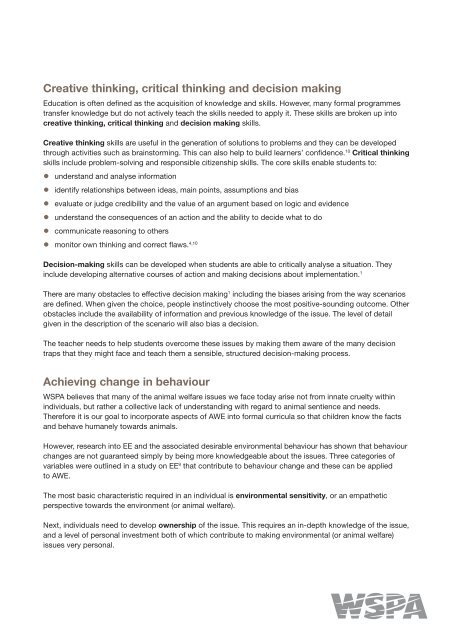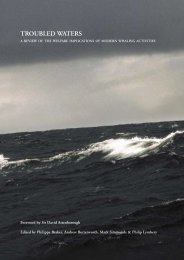WSPA - First Concepts: for teachers
WSPA - First Concepts: for teachers
WSPA - First Concepts: for teachers
Create successful ePaper yourself
Turn your PDF publications into a flip-book with our unique Google optimized e-Paper software.
Creative thinking, critical thinking and decision makingEducation is often defined as the acquisition of knowledge and skills. However, many <strong>for</strong>mal programmestransfer knowledge but do not actively teach the skills needed to apply it. These skills are broken up intocreative thinking, critical thinking and decision making skills.Creative thinking skills are useful in the generation of solutions to problems and they can be developedthrough activities such as brainstorming. This can also help to build learners’ confidence. 10 Critical thinkingskills include problem-solving and responsible citizenship skills. The core skills enable students to:• understand and analyse in<strong>for</strong>mation• identify relationships between ideas, main points, assumptions and bias• evaluate or judge credibility and the value of an argument based on logic and evidence• understand the consequences of an action and the ability to decide what to do• communicate reasoning to others• monitor own thinking and correct flaws. 4,10Decision-making skills can be developed when students are able to critically analyse a situation. Theyinclude developing alternative courses of action and making decisions about implementation. 1There are many obstacles to effective decision making 1 including the biases arising from the way scenariosare defined. When given the choice, people instinctively choose the most positive-sounding outcome. Otherobstacles include the availability of in<strong>for</strong>mation and previous knowledge of the issue. The level of detailgiven in the description of the scenario will also bias a decision.The teacher needs to help students overcome these issues by making them aware of the many decisiontraps that they might face and teach them a sensible, structured decision-making process.Achieving change in behaviour<strong>WSPA</strong> believes that many of the animal welfare issues we face today arise not from innate cruelty withinindividuals, but rather a collective lack of understanding with regard to animal sentience and needs.There<strong>for</strong>e it is our goal to incorporate aspects of AWE into <strong>for</strong>mal curricula so that children know the factsand behave humanely towards animals.However, research into EE and the associated desirable environmental behaviour has shown that behaviourchanges are not guaranteed simply by being more knowledgeable about the issues. Three categories ofvariables were outlined in a study on EE 9 that contribute to behaviour change and these can be appliedto AWE.The most basic characteristic required in an individual is environmental sensitivity, or an empatheticperspective towards the environment (or animal welfare).Next, individuals need to develop ownership of the issue. This requires an in-depth knowledge of the issue,and a level of personal investment both of which contribute to making environmental (or animal welfare)issues very personal.
















